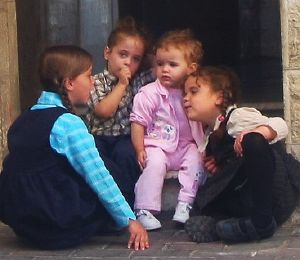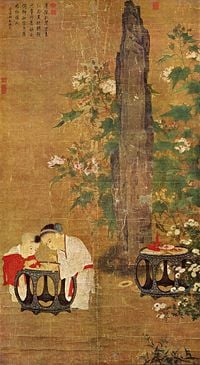Childhood
Childhood (being a child) is a broad term usually applied to the phase of development in humans between infancy and adulthood.



Definition
A child (plural: children) is a boy or girl who has not reached puberty, but also refers to offspring of any age. Adults remain the children of their parents, no matter what their age.
The legal definition of "child" is interchangeable with minor and may vary by country, in keeping with cultural conceptions.
The United Nations Convention on the Rights of the Child (1989), often referred to as CRC or UNCRC, an international convention setting out the civil, political, economic, social, and cultural rights of children, defines a child as "every human being below the age of eighteen years unless under the law applicable to the child, majority is attained earlier."
Attitudes toward children

Social attitudes toward children differ around the world, and these attitudes have changed over time.
Philippe Ariès (1965), a French medievalist and historian, revealed through his study of [painting]]s, diaries, furniture, and school records that the conception of childhood as a distinct and important phase of life is a relatively modern one. Prior to the seventeenth century, children, once weaned and grown beyond infancy, were regarded as mini-adults. They were dressed as such, expected to participate in family activities, including work, along with the adults. Since then historians have increasingly begun to research childhood in past times.
Before Ariès, George Boas had published The Cult of Childhood.
Several historical events and period are discussed as relevant to the history of childhood in the West.
During the Renaissance, artistic depictions of children increased dramatically in Europe. This did not impact the social attitude to children much, however, and children continued to be expected to work.
The Victorian Era has been described as a source of the modern institution of childhood. Ironically, the Industrial Revolution during this era led to an increase in child labor. Due to the campaigning of the Evangelicals, and efforts of author Charles Dickens and others, child labor was gradually reduced and halted in England via the Factory Acts of 1802-1878. The Victorians concomitantly emphasized the role of the family and the sanctity of the child, and broadly speaking, this attitude has remained dominant in Western societies since then.
Child development
Child development is the study of the processes and mechanisms that accompany the physical and psychological development of human beings as they mature from birth to adulthood. Since factors during pregnancy have been found to be significant in the development of an individual, the period from conception to birth may also be included in this field of study.
Most of the physical and mental development of a person takes place in childhood. In terms of physical development, early childhood is the time in which significant physical growth occurs, growth which depends on adequate nutrition and healthy physical exercise and environment. It is the critical period for establishing good habits of both exercise and nutrition which can last a lifetime. By the age of seven, nearly all of the motor control mechanisms in the brain are present and the child is rapidly developing motor skills. In preadolescence there are major growth spurts (usually experienced by girls between the ages of 9 and 12 years, and by boys between 11 and 14 years) muscles, tendons, and bones require reasonable exercise to develop well.
The following list reflects the division of ages of child development commonly found in the twenty-first century. However, these age ranges are approximate, and may differ from culture to culture.
- Zygote, the point of conception, fertilization.
- Embryo; in the later stages also called fetus.
- Neonate (newborn) in the first month outside of the womb.
- Infant (baby) (ages 0–1.5).
- Toddler (ages 1.5–4).
- Middle childhood - Primary school/Elementary school age (ages 5–10).
- Prepubescence, a subset of the above (ages 10–11, approximately).
- Preadolescence (preteen, or middle school age) (ages 11–13, approximately). Note overlap with prepubescent stage of middle childhood.
- Adolescence and puberty (teenager) (13–19).
- Child abuse
- Child custody
- Child development
- Child labor
- Child prodigy
- Child sexual abuse
- Child support
- Childcare
- Education, School
- Educational psychology
- Parenting
- Pedophilia
- Pedagogy
- Pediatrics
- Play
ReferencesISBN links support NWE through referral fees
- Ariès, Philippe. 1965.Centuries of Childhood: A Social History of Family Life. New York: Vintage. ISBN 978-0394702865
- Boas, George. [1966] 1990. The Cult of Childhood. Spring Publications. ISBN 978-0882142180
- Brown, Marilyn R. (ed.). 2002. Picturing Children: Constructions of Childhood between Rousseau and Freud. Aldershot: Ashgate, 2002. ISBN 978-0754602774
- Buckingham, David. After the Death of Childhood: Growing Up in the Age of Electronic Media. Blackwell Publishers. ISBN 0745619339.
- Bunge, Marcia J. (ed.). 2001. The Child in Christian Thought. Grand Rapids, MI: William B. Eerdmans Publishing Co. ISBN 978-0802846938
- Calvert, Karin. 1994. Children in the House: The Material Culture of Early Childhood, 1600-1900. Boston, MA: Northeastern University Press. ISBN 978-1555531898
- Cleverley, John, and D. C. Phillips. 1986. Visions of Childhood: Influential Models from Locke to Spock. New York, NY: Teachers College. ISBN 978-0807728000
- Cunningham, Hugh. 2005. Children and Childhood in Western Society since 1500. London: Longman. ISBN 978-0582784536
- Cunnington, Phillis, and Anne Buck. 1965. Children’s Costume in England: 1300 to 1900. Adam & Charles Black.
- deMause, Lloyde (ed.). 1995. The History of Childhood. London: Jason Aronson. ISBN 978-1568215518
- Eckstein, M. A. 1967. The Darling Young The Record 69: 91-95. Retrieved October 7, 2008.
- Higonnet, Anne. 1998. Pictures of Innocence: The History and Crisis of Ideal Childhood. London: Thomas and Hudson Ltd. ISBN 978-0500280485
- Immel, Andrea, and Michael Witmore (eds.). 2005. Childhood and Children’s Books in Early Modern Europe, 1550-1800. New York, NY: Routledge. ISBN 978-0415972581
- Kincaid, James R. 1994. Child-Loving: The Erotic Child and Victorian Culture. New York, NY: Routledge. ISBN 978-0415910033
- Müller, Anja (ed.). 2006. Fashioning Childhood in the Eighteenth Century: Age and Identity. Burlington, VT: Ashgate. ISBN 978-0754655091
- O’Malley, Andrew. 2003. The Making of the Modern Child: Children’s Literature and Childhood in the Late Eighteenth Century. London: Routledge. ISBN 978-0415942997
- Pinchbeck, Ivy, and Margaret Hewitt. 1969. Children in English Society. 2 vols. London: Routledge.
- Pollock, Linda A. 1984. Forgotten Children: Parent-child relations from 1500 to 1900. Cambridge: Cambridge University Press. ISBN 978-0521271332
- Postman, Neil. 1994. The Disappearance of Childhood. New York, NY: Vintage.
- Shorter, Edward. 1977. The Making of the Modern Family. Basic Books. ISBN 978-0465097227
- Sommerville, C. John. 1992. The Discovery of Childhood in Puritan England. Athens, GA: University of Georgia Press. ISBN 978-0820313535
- Steinberg, Shirley R. and Joe L. Kincheloe. 2004. Kinderculture: The Corporate Construction of Childhood. Westview Press Inc. ISBN 081339157.
- Stone, Lawrence. 1983. The Family, Sex and Marriage in England 1500-1800. New York, NY: Harper and Row. ISBN 978-0061319792
- Zornado, Joseph L. 2006. Inventing the Child: Culture, Ideology, and the Story of Childhood. New York, NY: Routledge. ISBN 978-0415979665
- Office of the High Commissioner for Human Rights. 1989. Convention on the Rights of the Child United Nations. Retrieved January 17, 2008.
- Vasta, Ross, Marshall M. Haith, and Scott A. Miller. 1998. Child Psychology: The Modern Science. Third Edition. New York, NY: John Wiley. ISBN 047119221X
- Landsdown, Richard, and Marjorie Walker. 1991. Your Child's Development from Birth through Adolescence. New York, NY: Alfred A. Knopf. ISBN 0394578147
- Kotre, John and Elizabeth Hall. 1990. Seasons of Life: Our Dramatic Journey from Birth to Death. Boston, MA: Little, Brown & Company. ISBN 0316502529
- Konner, Melvin. 1991. Childhood. Boston, MA: Little, Brown & Company. ISBN 0316501840
- Marten, James. 2008. Childhood, Encyclopedia of American History. Answers Corp. Retrieved October 18, 2008.
- Kagan, Jerome. 1984. The Nature of the Child. New York, NY: Basic Books. ISBN 046504851X
- Breiner, Sander J. 1990. Slaughter of the Innocents: Child Abuse Through the Ages and Today. Plenum Publishing Corporation. ISBN 0306434598
External links
All links Retrieved January 17, 2008.
- CDC's "Learn the Signs. Act Early.” campaign - Information for parents on early childhood development and developmental disabilities
- Historical children photos
- World Childhood Foundation
Credits
New World Encyclopedia writers and editors rewrote and completed the Wikipedia article in accordance with New World Encyclopedia standards. This article abides by terms of the Creative Commons CC-by-sa 3.0 License (CC-by-sa), which may be used and disseminated with proper attribution. Credit is due under the terms of this license that can reference both the New World Encyclopedia contributors and the selfless volunteer contributors of the Wikimedia Foundation. To cite this article click here for a list of acceptable citing formats.The history of earlier contributions by wikipedians is accessible to researchers here:
The history of this article since it was imported to New World Encyclopedia:
Note: Some restrictions may apply to use of individual images which are separately licensed.